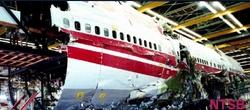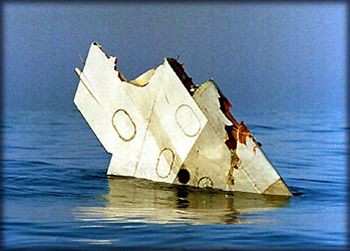Says More Needs To Be Done On Fuel Tank Safety
 With the 10th
anniversary of the crash of TWA Flight 800 approaching, last week
the National Transportation Safety Board released a fact sheet that
reviews lessons learned from the accident investigation... and the
progress toward ensuring that similar tragedies do not happen in
the future.
With the 10th
anniversary of the crash of TWA Flight 800 approaching, last week
the National Transportation Safety Board released a fact sheet that
reviews lessons learned from the accident investigation... and the
progress toward ensuring that similar tragedies do not happen in
the future.
The Board's review found that significant safety improvements
have been implemented over the past ten years, but that more needs
to be done to avoid another accident like TWA 800.
"The crash of TWA 800 was a watershed event for the air carrier
industry," said NTSB Acting Chairman Mark V. Rosenker. "In the
intervening years, a lot of thought and effort has been devoted to
the issues raised by this accident, and the public is safer for
it."
TWA 800, a Boeing 747, crashed on July 17, 1996, minutes after
takeoff from John F. Kennedy International Airport on a flight to
Paris, France. All 230 persons aboard the airplane died in the
accident. The Safety Board conducted an exhaustive four-year
investigation and determined that the accident was caused by an
explosion in the center wing fuel tank, resulting from ignition of
the flammable fuel/air mixture in the tank.
The NTSB says the most prominent issues raised by the TWA 800
accident concerned protection against flammable fuel tank vapors,
and aging electrical systems.
Rosenker noted that fleet-wide inspections and analytical
reviews of fuel tank design have resulted in significant measures
that have the potential to reduce the likelihood of an ignition
event inside a tank, and that fuel pumps, fuel quantity indicating
systems, in-tank wiring, co-routed wiring, and operational
procedures have been modified to make fuel systems safer.
 "Equally important,"
Rosenker said, "is the prospect of substantially reducing fuel tank
flammability exposure - something that was seen as impractical ten
years ago but is now feasible, even in this difficult era when
airline operators need to be extremely conscious of costs."
"Equally important,"
Rosenker said, "is the prospect of substantially reducing fuel tank
flammability exposure - something that was seen as impractical ten
years ago but is now feasible, even in this difficult era when
airline operators need to be extremely conscious of costs."
But while applauding the FAA and industry for the progress that
has been made, Rosenker cautioned that the process is moving much
too slowly.
"Ten years after the TWA accident, fuel tank inerting systems
are not in place on our airliners, and flammability exposure is
largely unchanged. And proposed rule changes do not include the
majority of fuel tanks which are in the wings of transport
airplanes, nor this country's large fleet of cargo aircraft."
Consequently, he added, reduction in fuel tank flammability
remains on the NTSB's Most Wanted List of Safety Improvements.
Rosenker also expressed disappointment that the FAA did not act
on the NTSB's immediate, interim recommendations, issued a few
months after the TWA accident, that were aimed at reducing the fuel
tank flammability problem until longer- term solutions are in
place. The recommendation was closed by the Safety Board last year
and given an "unacceptable action" status.

Rosenker noted that the TWA accident gave great impetus to
legislation that revolutionized the ability of the families of the
victims to obtain accurate and timely information about an airliner
accident and the subsequent investigation.
 Aero-News: Quote of the Day (04.28.25)
Aero-News: Quote of the Day (04.28.25) ANN's Daily Aero-Term (04.28.25): Decision Altitude (DA)
ANN's Daily Aero-Term (04.28.25): Decision Altitude (DA) ANN's Daily Aero-Linx (04.28.25)
ANN's Daily Aero-Linx (04.28.25) Airborne-Flight Training 04.24.25: GA Refocused, Seminole/Epic, WestJet v TFWP
Airborne-Flight Training 04.24.25: GA Refocused, Seminole/Epic, WestJet v TFWP Aero-News: Quote of the Day (04.29.25)
Aero-News: Quote of the Day (04.29.25)





